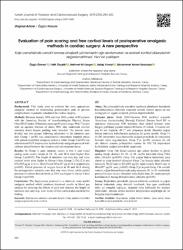| dc.contributor.author | Özmen, Özgür | |
| dc.contributor.author | Özçelik, Fatih | |
| dc.contributor.author | Kaygın, Mehmet Ali | |
| dc.contributor.author | Yılmaz, Habip | |
| dc.contributor.author | Karakaya, Muhammet Ahmet | |
| dc.date.accessioned | 2019-12-23T12:45:53Z | |
| dc.date.available | 2019-12-23T12:45:53Z | |
| dc.date.issued | 2019 | en_US |
| dc.identifier.citation | Özmen, Ö., Özçelik, F., Kaygın, M. A., Yılmaz, H. ve Karakaya, M. A., (2019). Evaluation of pain scoring and free cortisol levels of postoperative analgesic methods in cardiac surgery: A new perspective. Turkish Journal of Thoracic and Cardiovascular Surgery, 27(3), 264-303. http://doi.org/10.5606/tgkdc.dergisi.2019.15143 | en_US |
| dc.identifier.issn | 1301-5680 | |
| dc.identifier.uri | http://doi.org/10.5606/tgkdc.dergisi.2019.15143 | |
| dc.identifier.uri | https://hdl.handle.net/20.500.12511/4615 | |
| dc.description.abstract | Background: This study aims to evaluate the most appropriate analgesic method of minimizing postoperative pain to prevent complications in patients scheduled for cardiac surgery. Methods: Between January 2016 and June 2016, a total of 60 patients with the American Society of Anesthesiologists Physical Status Class III (27 males, 33 females; mean age 63 years; range, 49 to 77 years) with an ejection fraction of above 50% who underwent elective coronary artery bypass grafting were included. The patients were divided into two groups following admission to the intensive care unit. Group 1 (n=30) was administered intravenous fentanyl citrate with patient-controlled analgesia protocol, while Group 2 (n=30) was administered 0.1% bupivacaine hydrochloride analgesia protocol with catheter placed between the sternum and subcutaneous tissue. Results: In Group 1, pain intensity scores at two h and visual analog scale scores except at 24, 36, and 48 h were higher than Group 2 (p<0.05). The length of intensive care unit stay and urine cortisol levels were higher in Group 1 than Group 2 (78±12 h and 631±505 μg at 24 h vs. 66±13 h and 401±297 μg at 24 h, respectively p<0.05). Partial pressure of oxygen levels at 10 and 16 h during the postoperative intensive care unit stay were lower, while partial pressure of carbon dioxide levels at 24 h was higher in Group 1 than Group 2 (p<0.05). Conclusion: The bupivacaine protocol is a relatively more useful analgesic method which produces improved results in blood gas analysis by reducing the effects of pain and shortens the length of intensive care unit stay. Low levels of free cortisol also confirm this finding. | en_US |
| dc.description.abstract | Amaç: Bu çalışmada kalp cerrahisi yapılması planlanan hastalarda komplikasyonları önlemek amacıyla cerrahi sonrası ağrıyı en aza indirgeyen en uygun analjezik yöntem değerlendirildi. Çalışma planı: Ocak 2016-Haziran 2016 tarihleri arasında Amerikan Anesteziyoloji Derneği Fiziksel Durum Sınıf III ve ejeksiyon fraksiyonu %50 üzerinde olup elektif koroner arter baypas greftleme yapılan toplam 60 hasta (27 erkek, 33 kadın; ort. yaş 63 yıl; dağılım, 49-77 yıl) çalışmaya alındı. Hastalar yoğun bakım ünitesine kabullerinin ardından iki gruba ayrıldı. Grup 1’e (n=30) intravenöz hasta kontrollü analjezi protokolü ile intravenöz fentanil sitrat uygulanırken, Grup 2’ye (n=30) sternum ile cilt altı dokusu arasına yerleştirilen kateter ile %0.1’lik bupivakain hidroklorür analjezi protokolü uygulandı. Bulgular: Grup 1’de ikinci saatteki ağrı şiddet skorları ve görsel analog ölçeği skorları 24, 36. ve 48. saatler haricinde Grup 2’den daha yüksekti (p<0.05). Grup 1’de yoğun bakım ünitesinde yatış süresi ve idrar kortizol düzeyleri Grup 2’ye kıyasla daha yüksekti (sırasıyla 78±12 saat ve 631±505 µg/24. saate kıyasla 66±13 saat ve 401±297 µg/24. saat, p<0.05). Grup 2’ye kıyasla Grup 1’de cerrahi sonrası yoğun bakım ünitesinde yatış sırasında 10. ve 16. saatlerdeki parsiyel oksijen basıncı düzeyleri daha düşük iken, 24. saatte parsiyel karbondioksit basınç düzeyleri daha yüksekti (p<0.05). Sonuç: Bupivakain protokolü, ağrının etkilerini azaltarak ve yoğun bakım ünitesinde yatış süresini kısaltarak, kan gazı analizinde daha iyi sonuçlar sağlayan, nispeten daha kullanışlı bir analjezi yöntemidir. İdrarda serbest kortizol düzeylerinin düşüklüğü de, bu bulguyu doğrulamaktadır. | en_US |
| dc.language.iso | eng | en_US |
| dc.publisher | Baycinar Medical Publishing | en_US |
| dc.rights | info:eu-repo/semantics/openAccess | en_US |
| dc.subject | Bupivacaine | en_US |
| dc.subject | Intensive Care Unit | en_US |
| dc.subject | Length of Stay | en_US |
| dc.subject | Patient-Controlled Analgesia Protocol | en_US |
| dc.subject | Urine Cortisol | en_US |
| dc.subject | Bupivakain | en_US |
| dc.subject | Yoğun Bakım Ünitesi | en_US |
| dc.subject | Yatış Süresi | en_US |
| dc.subject | Hasta Kontrollü Analjezi Protokolü | en_US |
| dc.subject | İdrar Kortizol | en_US |
| dc.title | Evaluation of pain scoring and free cortisol levels of postoperative analgesic methods in cardiac surgery: A new perspective | en_US |
| dc.title.alternative | Kalp cerrahisinde cerrahi sonrası analjezik yöntemlerin ağrı skorlamaları ve serbest kortizol düzeylerinin değerlendirilmesi: Yeni bir yaklaşım | en_US |
| dc.type | article | en_US |
| dc.relation.ispartof | Turkish Journal of Thoracic and Cardiovascular Surgery | en_US |
| dc.department | İstanbul Medipol Üniversitesi, Tıp Fakültesi, Cerrahi Tıp Bilimleri Bölümü, Anesteziyoloji ve Reanimasyon Ana Bilim Dalı | en_US |
| dc.authorid | 0000-0002-9139-1080 | en_US |
| dc.identifier.volume | 27 | en_US |
| dc.identifier.issue | 3 | en_US |
| dc.identifier.startpage | 294 | en_US |
| dc.identifier.endpage | 303 | en_US |
| dc.relation.publicationcategory | Makale - Uluslararası Hakemli Dergi - Kurum Öğretim Elemanı | en_US |
| dc.identifier.doi | 10.5606/tgkdc.dergisi.2019.15143 | en_US |
| dc.identifier.wosquality | Q4 | en_US |
| dc.identifier.scopusquality | Q4 | en_US |


















